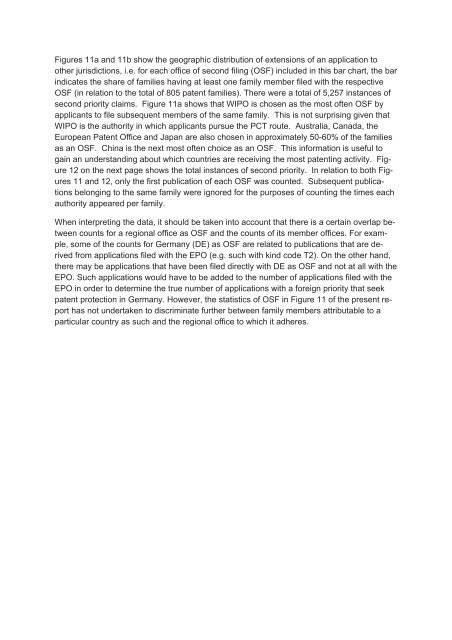Patent Landscape Report on Ritonavir - WIPO
Patent Landscape Report on Ritonavir - WIPO
Patent Landscape Report on Ritonavir - WIPO
You also want an ePaper? Increase the reach of your titles
YUMPU automatically turns print PDFs into web optimized ePapers that Google loves.
Figures 11a and 11b show the geographic distributi<strong>on</strong> of extensi<strong>on</strong>s of an applicati<strong>on</strong> toother jurisdicti<strong>on</strong>s, i.e. for each office of sec<strong>on</strong>d filing (OSF) included in this bar chart, the barindicates the share of families having at least <strong>on</strong>e family member filed with the respectiveOSF (in relati<strong>on</strong> to the total of 805 patent families). There were a total of 5,257 instances ofsec<strong>on</strong>d priority claims. Figure 11a shows that <strong>WIPO</strong> is chosen as the most often OSF byapplicants to file subsequent members of the same family. This is not surprising given that<strong>WIPO</strong> is the authority in which applicants pursue the PCT route. Australia, Canada, theEuropean <str<strong>on</strong>g>Patent</str<strong>on</strong>g> Office and Japan are also chosen in approximately 50-60% of the familiesas an OSF. China is the next most often choice as an OSF. This informati<strong>on</strong> is useful togain an understanding about which countries are receiving the most patenting activity. Figure12 <strong>on</strong> the next page shows the total instances of sec<strong>on</strong>d priority. In relati<strong>on</strong> to both Figures11 and 12, <strong>on</strong>ly the first publicati<strong>on</strong> of each OSF was counted. Subsequent publicati<strong>on</strong>sbel<strong>on</strong>ging to the same family were ignored for the purposes of counting the times eachauthority appeared per family.When interpreting the data, it should be taken into account that there is a certain overlap betweencounts for a regi<strong>on</strong>al office as OSF and the counts of its member offices. For example,some of the counts for Germany (DE) as OSF are related to publicati<strong>on</strong>s that are derivedfrom applicati<strong>on</strong>s filed with the EPO (e.g. such with kind code T2). On the other hand,there may be applicati<strong>on</strong>s that have been filed directly with DE as OSF and not at all with theEPO. Such applicati<strong>on</strong>s would have to be added to the number of applicati<strong>on</strong>s filed with theEPO in order to determine the true number of applicati<strong>on</strong>s with a foreign priority that seekpatent protecti<strong>on</strong> in Germany. However, the statistics of OSF in Figure 11 of the present reporthas not undertaken to discriminate further between family members attributable to aparticular country as such and the regi<strong>on</strong>al office to which it adheres.

















